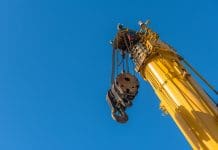Dr Julie Riggs DProf MSc CMIOSH, Lead Diploma Tutor at Phoenix Health and Safety discusses the issues of working at height after it’s revealed as the most frequent cause of fatal accidents in 2017 by the HSE
Working at height is commonplace in a number of industries, from electricians and builders to window cleaners and firefighters.
With working at height comes risk. According to the latest HSE statistics, working from height was the most frequent cause of fatal accidents to workers in 2017, accounting for 28% of the total. There were also 43,000 non-fatal accidents involving falls from height across all industries. Over 60% of deaths during work at height involve falls from ladders, scaffolds, working platforms and roof edges and through fragile roofs.
Typical preventable accidents
Causes of typical accidents involving working at height include using ladders and stepladders incorrectly, overstretching from ladders and standing on benches or chairs to reach high surfaces. Accidents can also involve access equipment, such as mobile elevated work platforms (MEWP) and suspended access equipment (SAE); window cleaning cradles for example. The big question is how can a business keep its workers safe, and stay compliant with its legal and regulatory obligations?
HSE guidance on minimising risk
In their working from height guidance, the Health and Safety Executive (HSE) detail simple steps to minimise the risk. This invaluable advice for cleaning contractors can be summarised as:
- Avoid work at height when there’s a practical alternative
- Use the right type of equipment and ensure that it is stable, strong enough for the job and maintained correctly
- Ensure workers can get to their working position safely
- Don’t overload or over-reach when working at height
- Take precautions when working on or near fragile surfaces
- Provide protection from falling objects
- Prepare and know the emergency evacuation and rescue procedures.
What the law says
The Health and Safety at Work Act 1974 (HSW Act) requires employers to ensure the health, safety and welfare of their employees and to ensure that those affected by their activities are not exposed to risk, so far as is reasonably practicable.
The Work at Height Regulations 2005 require employers and those in control of any work at height activity to ensure that the work is properly planned, well supervised and carried out by competent people.
Who is a competent person?
In general terms being competent to work at height means having the right skills, knowledge, training and experience. The precise definition of competence for a specific job depends on the nature of the work and the equipment being used.
Assess the risk, record it and keep adjusting it
You can’t prepare for or avoid a risk unless you understand it, so risk assessment is essential to safety. Consider everything that can go wrong, decide on the precautions required and write down the findings.
Instruct and train your workforce in the precautions needed. Method statements are widely used in the construction industry and are an effective way to help manage the work and communicate what is required, so that everyone involved is working with the same information. The statement need be no longer than necessary to achieve these objectives effectively. Above all it should be clear, so using simple sketches to illustrate key points is a great idea. Statements are for the benefit of those carrying out the work and their immediate supervisors and should be as clear and simple as possible. Often the work at height risk is obvious or well known, so the necessary control measures are straightforward.
Finally, be sure to review the assessment regularly and change it whenever necessary. Often the full reality of a hazard only becomes apparent after a task has been completed.
Planning is key
The law on working at height requires employers to take into account the risk assessment when organising and planning work. That’s how the precautions required can be identified and work carried out with optimum safety.
HSE’s clear advice is to avoid working at height whenever it is reasonably practicable to do so. That can mean using alternative methods such as telescopic water fed poles or, most simply of all, cleaning the windows from the inside. The next option should be using an existing place of work that is already safe: a balcony for example.
But of course there are times when working at height is unavoidable. That’s when employers must make sure that the people doing the work are trained and competent, and that the equipment provided is suitable, properly maintained and will be correctly used.
Where using the equipment involves a risk of falling, additional measures to minimise the distance and consequences of any fall must be put in place. Prevent any person falling a distance liable to cause personal injury, for example by using a scaffold platform with double guard-rail and toeboards
Equally importantly, arrest a fall with equipment to minimise the distance and consequences of a fall. Options include safety nets, where work at height cannot be avoided or the risk of falling prevented.
Remember, whenever work at height accidents are investigated and employers are prosecuted, one of the most common findings is that the work was not properly planned and supervised.
Involve everyone
An important part of the planning process is consulting the building owner or client. They will know, for example, if the window and/or building design allows for safe access from the inside, so that working from height can be avoided. When everyone is working together with an agreed and co-ordinated approach, that’s the simplest way to reduce the risks.
Be as proactive as possible
The old ‘prevention is better than cure’ saying has never been truer than it is when working at height. When things go wrong, people suffer injuries, sometime fatal. So being ahead of the game is literally a matter of life and death. Assess the risks accurately and change the assessment as soon as new information is available. Prepare people and equipment thoroughly and never, ever cut corners on safety procedures.
Dr Julie Riggs
Lead Diploma Tutor
Phoenix Health and Safety


![[Video] Fireco: 80 new fire doors required for residential flats in London](https://www.pbctoday.co.uk/news/wp-content/uploads/2025/04/2024-06-01-Lords-view-one_1200x750_004-218x150.webp)










![[VIDEO]What to expect when you’re inspecting: Using DorTrak for fire door inspections](https://www.pbctoday.co.uk/news/wp-content/uploads/2025/02/maxresdefault-218x150.jpg)